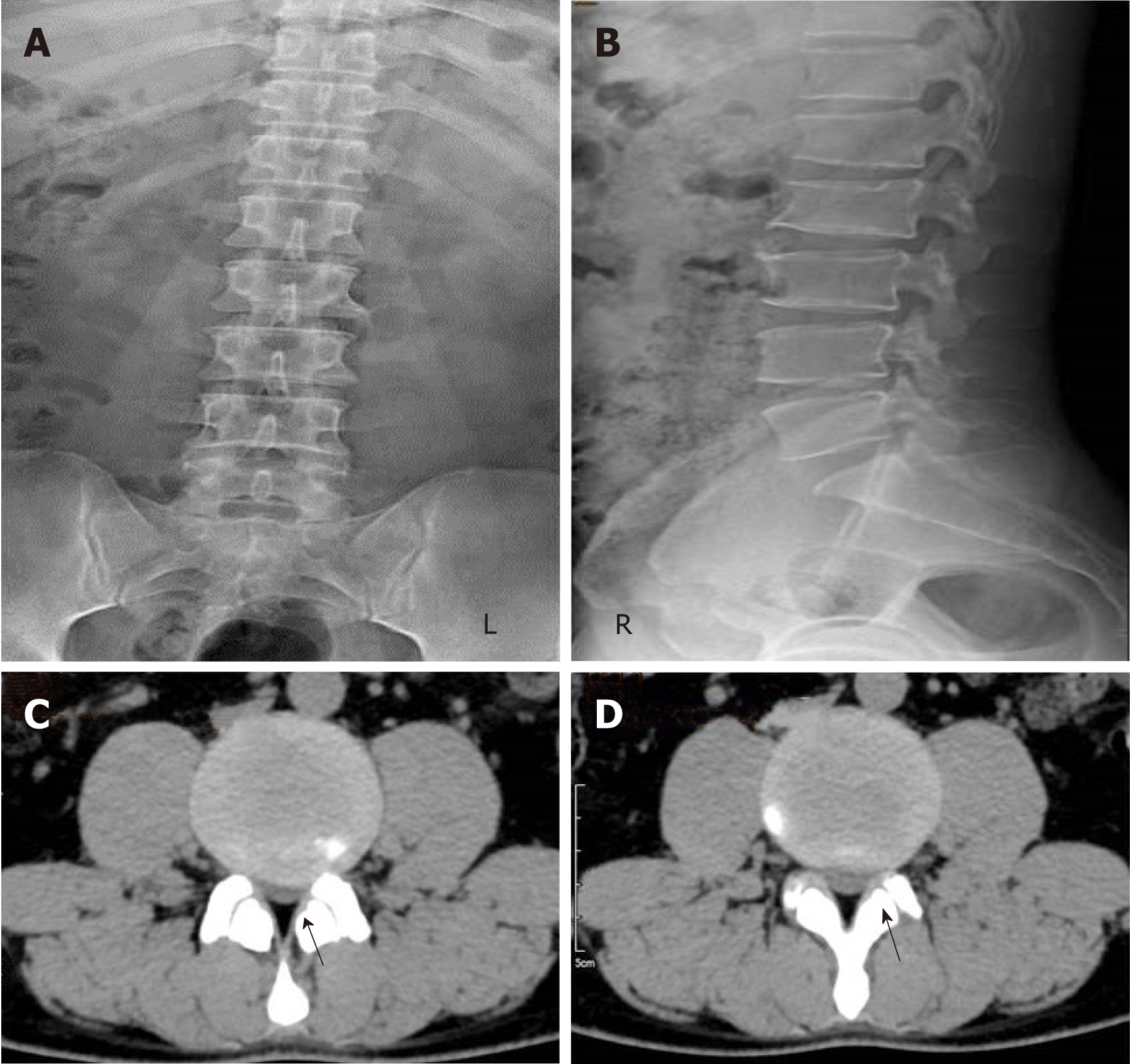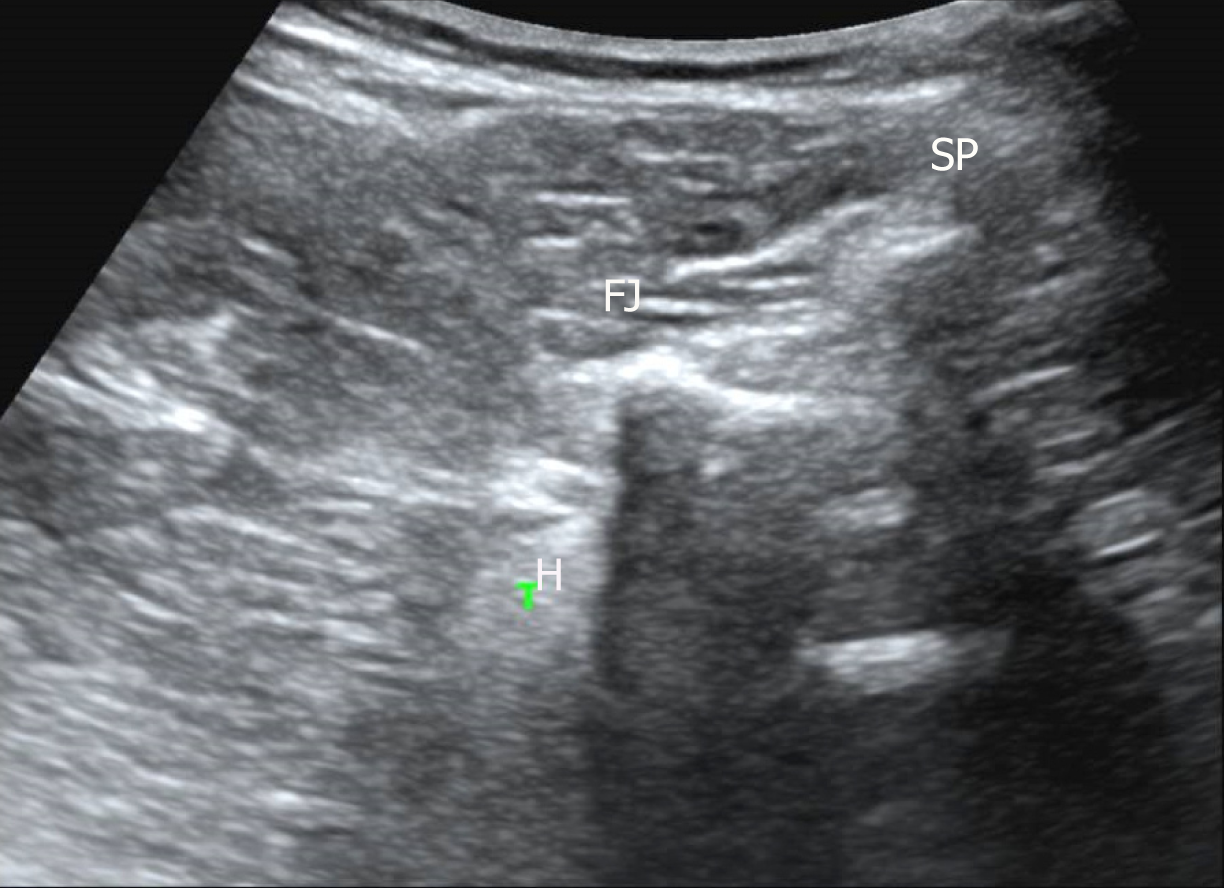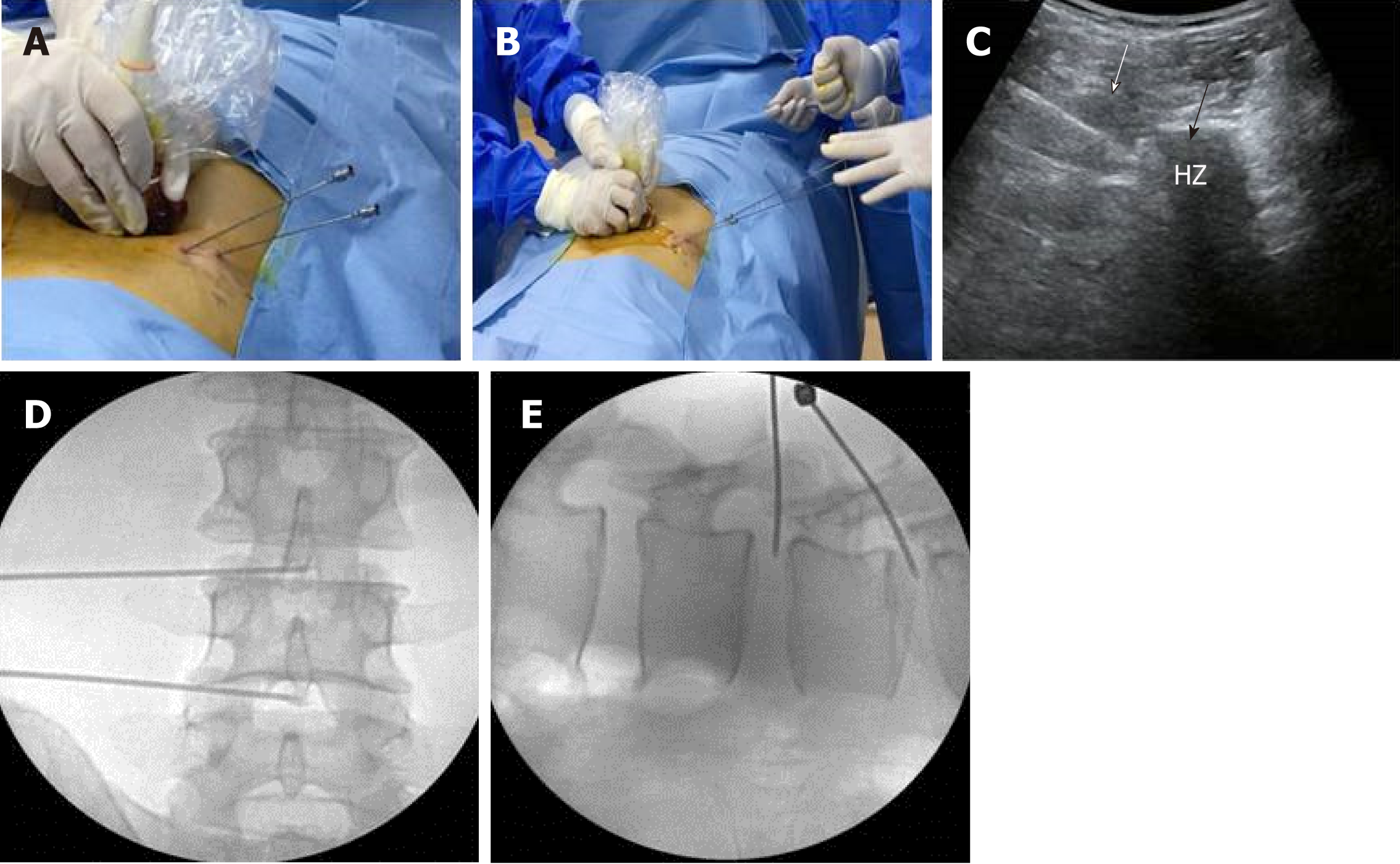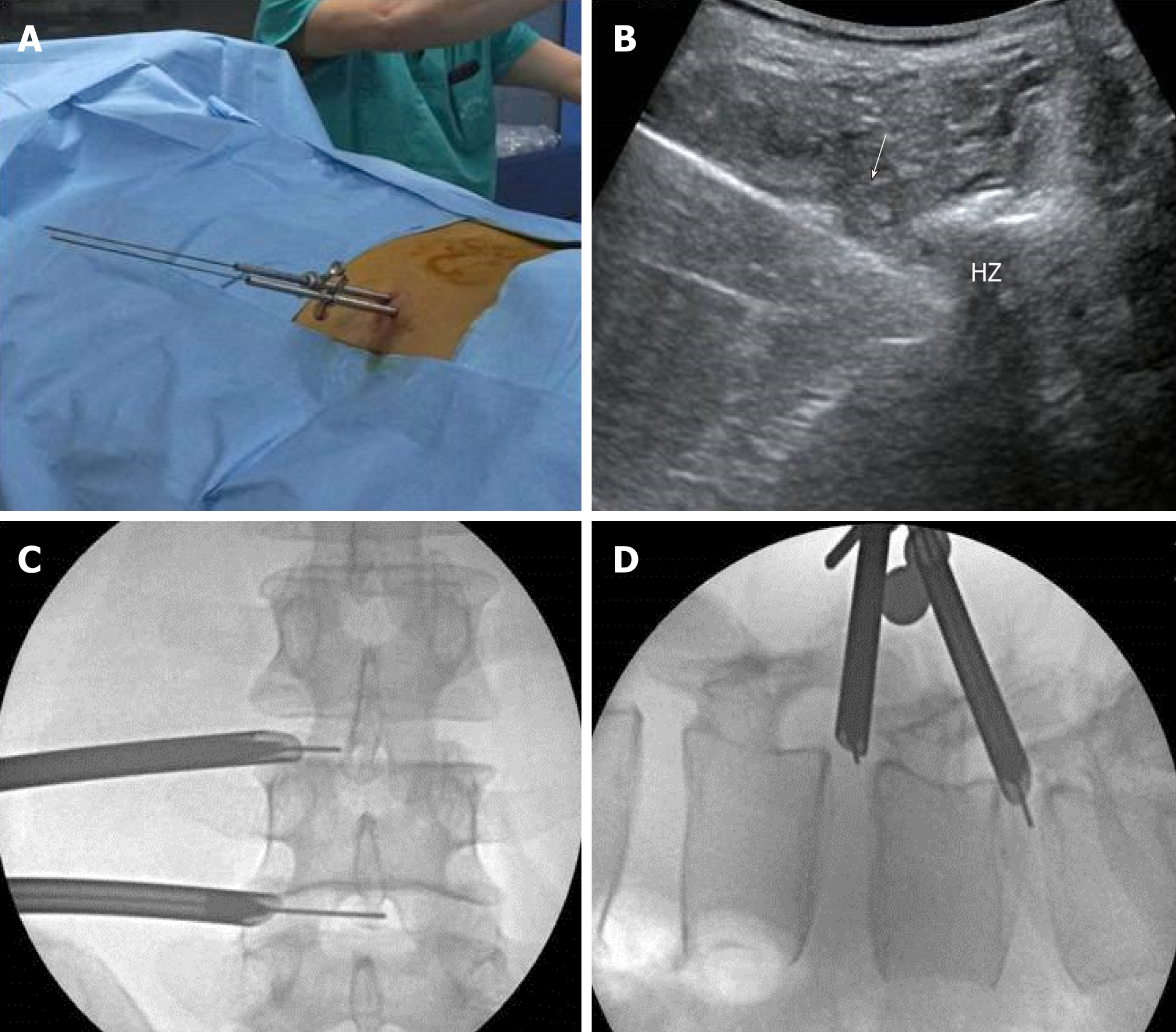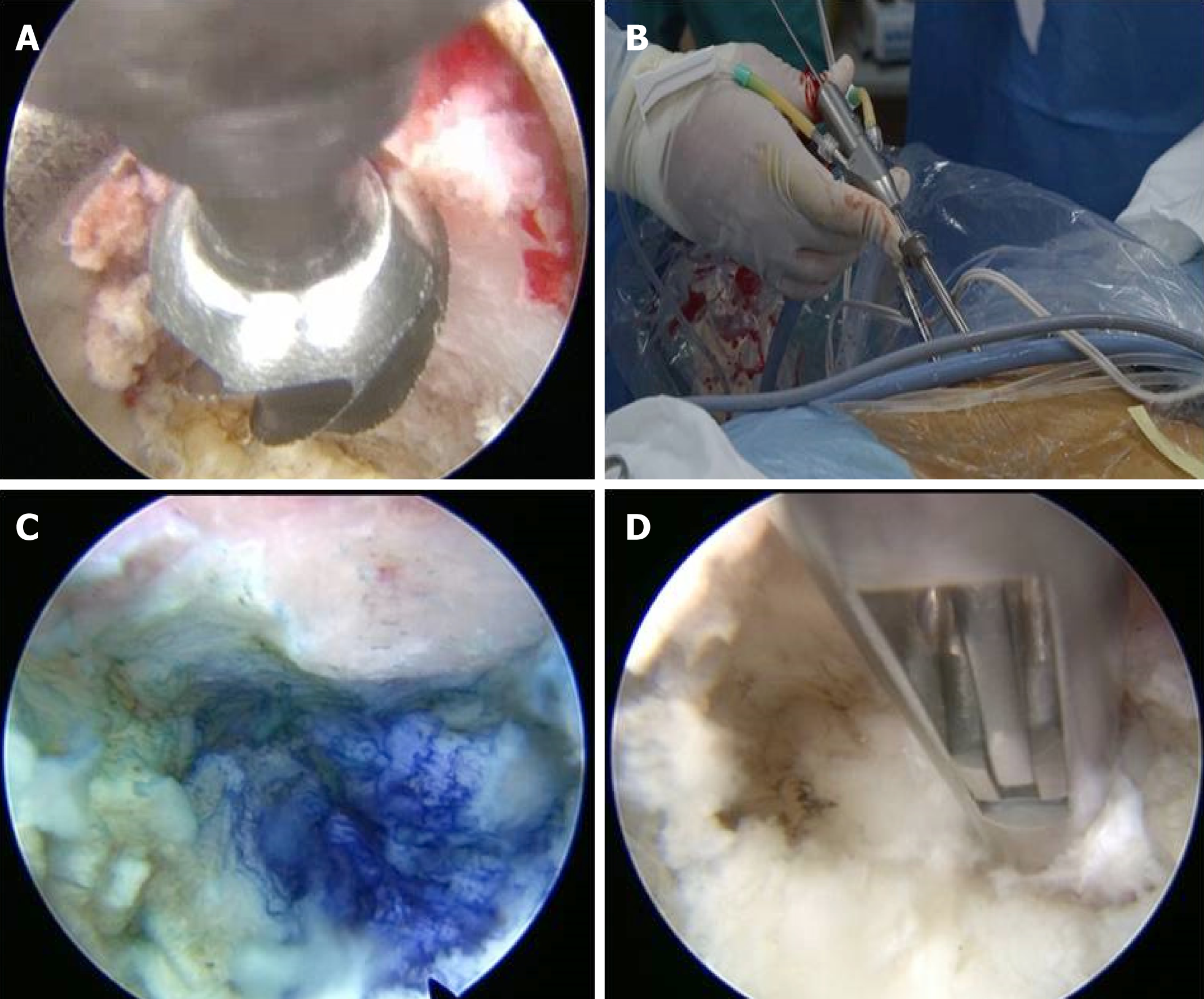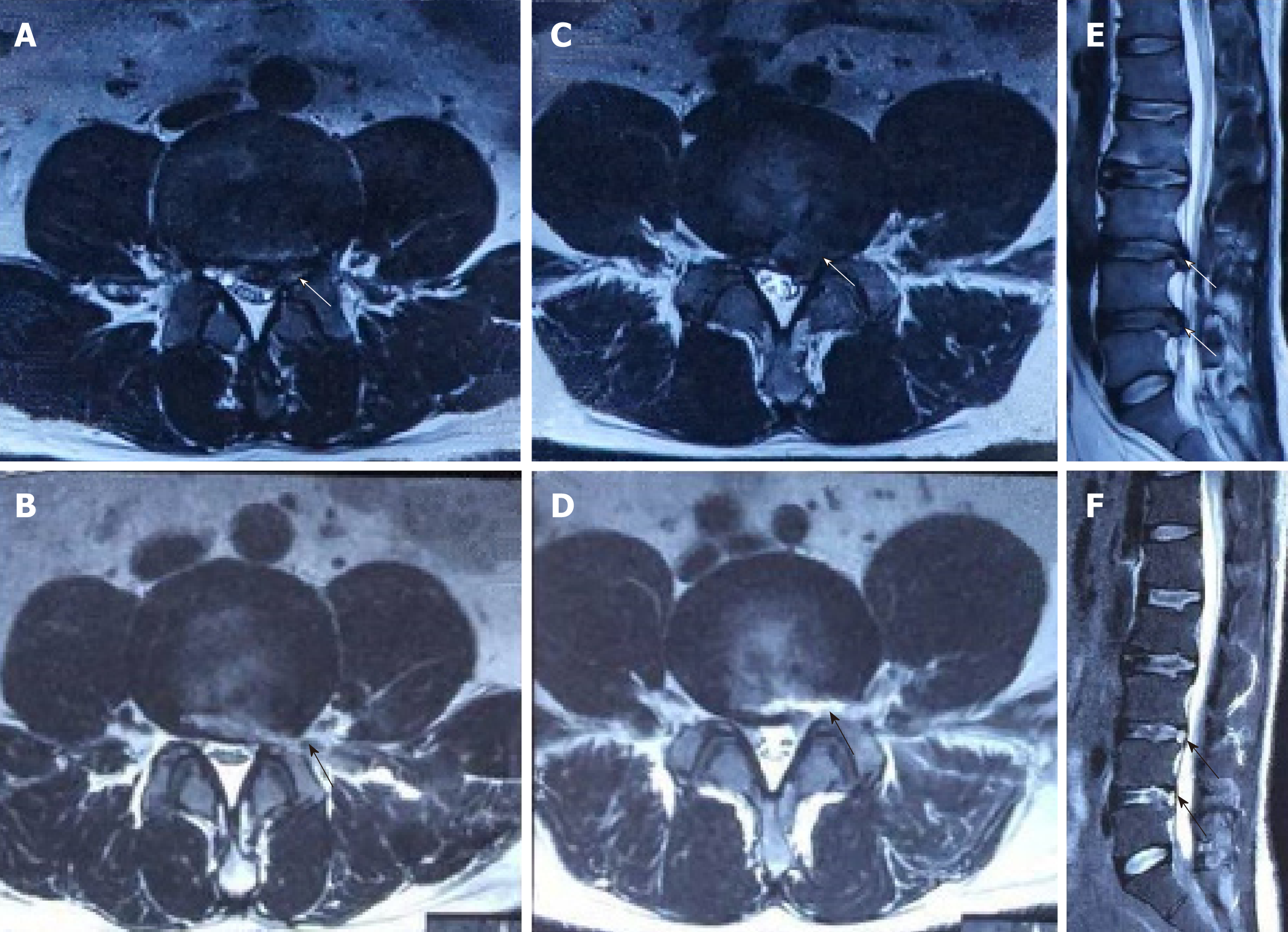Published online May 26, 2019. doi: 10.12998/wjcc.v7.i10.1161
Peer-review started: January 14, 2019
First decision: January 30, 2019
Revised: March 1, 2019
Accepted: March 16, 2019
Article in press: March 16, 2019
Published online: May 26, 2019
Processing time: 135 Days and 1.7 Hours
Percutaneous endoscopic lumbar discectomy (PELD) has become a mature and mainstream minimally invasive surgical technique for treating lumbar disc herniation (LDH). Repeated fluoroscopy, with more than 30 shots on average, is inevitable to ensure its accuracy and safety. However, exposure to X-rays may pose a threat to human health. We herein report a case of ultrasound (US)-assisted PELD in two levels of LDH to explore a new possibility that can reduce the radiation dose during puncture and cannulation in PELD.
A 38-year-old man with low back pain and left leg pain for more than 7 years came to our clinic, his symptoms had aggravated for 1 month, and he was diagnosed with L3-4 and L4-5 disc herniations. He received US-guided PELD with good results: His straight leg elevation increased from 40 to 90 degrees after PELD, and his visual analog scale (VAS) and Oswestry Disability Index scores both significantly decreased immediately and 6 mo after PELD. With the guidance of US, he received only two shots of fluoroscopy (fluoroscopic time: 4.4 s; radiation dose: 3.98 mGy). To our knowledge, this is the first case of US-guided puncture and cannulation of PELD for LDH at two levels.
US could be used to guide PELD and has the potential to largely reduce radiation than traditional X-ray guidance.
Core tip: Percutaneous endoscopic lumbar discectomy, a mature and mainstream minimally invasive surgical technique for treating lumbar disc herniation (LDH), needs more than 30 shots of fluoroscopy each level on average, causing a threat to human health. With the help of ultrasound (US) guidance, we report a patient with two levels of LDH who received only two shots to achieve satisfactory results. US guidance has great potential to become an alternative method to reduce radiation largely.
- Citation: Zhang MB, Yan LT, Li SP, Li YY, Huang P. Ultrasound guidance for transforaminal percutaneous endoscopic lumbar discectomy may prevent radiation exposure: A case report. World J Clin Cases 2019; 7(10): 1161-1168
- URL: https://www.wjgnet.com/2307-8960/full/v7/i10/1161.htm
- DOI: https://dx.doi.org/10.12998/wjcc.v7.i10.1161
Transforaminal percutaneous endoscopic lumbar discectomy (PELD) has become a mature and mainstream minimally invasive surgical technique for treating lumbar disc herniation (LDH)[1-4]. Fluoroscopy, to ensure the accuracy of puncture and cannulation, is inevitable. However, radiation exposure with X-ray guidance of PELD may be of concern because of its deleterious effects for both patients and surgeons. Therefore, an image guiding system without X-ray is needed to perform PELD. Ultrasound (US) is a real-time dynamic imaging facility with no ionizing radiation. We herein report a case of US-assisted PELD on a 38-year-old man with two levels of LDH at the same time. Our successful experience may contribute to the application of US-guided PELD in the future.
A 38-year-old man [height: 174 cm; weight: 74.5 kg; body mass index (BMI): 24.6 kg/m2] with low back pain and left leg pain for more than 7 years and aggravated symptoms for 1 mo came to our hospital.
His previous history and family history were negative. He had lameness on his left leg.
Physical examination showed tenderness and percussion pain radiation to the left leg from the left part of the L4-S1 vertebral spinous processes. Dermal sensation in his left lateral leg and left foot was decreased. Left straight leg raising and strengthening test had positive results (40 degrees).
X-ray showed small curvature of the lumbar spine. Computed tomography (CT) and magnetic resonance imaging (MRI) showed L3-4 and L4-5 disc herniations (left margin type) (Figure 1).
The patient was diagnosed with LDH of the L3-4 and L4-5 levels (left margin type).
The patient needed PELD of both L3-4 and L4-5 levels. Institutional approval for PELD was obtained from the ethics committee of our hospital, and the procedure in this study was performed in accordance with the tenets of the Declaration of Helsinki. Written informed consent was obtained from the patient. A portable Mindray M9 US system (Mindray, Shenzhen, China) with a C5-1S convex array transducer (central frequency: 5 MHz) was used in this study. The patient laid in a prone position on a radiolucent table with a pillow under his belly. One US physician with more than 4 years of experience in interventional US performed the US guidance. First, a longitudinal section was used to display the transverse processes, and the lowest transverse process was L5. Second, the probe was rotated by 90 degrees to display the L5 transverse process. The probe was moved upward, and the soft tissue in the intervertebral foramen of L4-5 appeared as a circular hyperechoic zone (HZ), which was located below the facet joint (Figure 2). The auxiliary line on the patient’s back skin was drawn at least 9-13 cm away from the midline. Third, the probe was moved to the next highest level to locate the L3-4 intervertebral disc using the same method.
One spinal surgeon with more than 5 years of experience in PELD performed the puncture and cannulation under the guidance of US (Figure 3). The HZ, which was located below the facet joint, was used as the target, and the needle was inserted from the 12 o’clock position to the 3 o’clock position of the HZ. The tip of the 18-gauge spinal needle first touched the facet joint and then slipped into the intervertebral foramen. G-arm X-ray (Whale, Massachusetts, United States) in the anteroposterior and lateral views was used to confirm that the needle tip arrived at the target point. A special instrument set (transforaminal endoscopic surgical system; joimax® GmbH, 102 Karlsruhe, Germany) was applied in the procedure. The guidewire was inserted through the spinal needle, which was removed thereafter. Then, the obturator and reamer were introduced along the guidewire. Finally, the expanders and outer sheath of the endoscope were inserted through the guidewire one after another (Figure 4).
The US-guided puncture lasted 4.5 min (2 min for L3-4 and 2.5 min for L4-5), and the US-guided cannulation lasted 5.5 min (2.5 min for L3-4 and 3 min for L4-5). The positions of the puncture needles and working sheaths were accurate, which was tested by two shots of G-arm fluoroscopy, with a total fluoroscopic time of 4.4 s and a total radiation dose of 3.98 mGy. Partial hypertrophied facetectomy was performed using a 3.0-mm endoscopic lateral bur (drill diameter: 3.0 mm, XISHAN, China) (Figure 5). Then, transforaminal PELD was performed as previously described by Wen et al[5].
The operation decompression lasted 82 minutes for two levels (Figure 5B-D), and it was completed with no complications. The patient's straight leg elevation increased from 40 to 90 degrees after PELD (Figure 6). Immediately following PELD, the visual analog scale (VAS) score of his low back pain decreased from 6 to 1, his leg pain score decreased from 8 to 1, and his Oswestry Disability Index (ODI) score decreased from 73 to 11. Videos of the patient’s gait immediately after surgery showed a normal and symmetric appearance of the two legs, and the spinal MRI after PELD showed complete decompression of the two levels (Figure 7). The patient was taught a set of waist exercises after the operation to reduce the recurrence of disc herniation after PELD. Follow-up at 6 months after PLED showed that the treatment effect remained the same without recurrence, with the patient showing 90 degrees of straight leg elevation, a VAS of 1 for both low back pain and leg pain, and an ODI of 10. The pati-ent was very satisfied with the treatment, especially with the reduction of radiation.
Repeated fluoroscopic scanning is essential for the puncture and cannulation during PELD. Fan et al[6] showed that 34.32 ± 4.78 fluoroscopy shots were needed in conventional PELD. They showed that this number was 33.98 ± 2.69 in another group of patients[7]. Patients with more difficult positioning and more treatment levels may receive larger radiation dose, and the same effect will occur in inexperienced surgeons. Fluoroscopic scanning may increase the incidence of malignant tumors, such as thyroid cancer, skin erythema, leukemia and so on[8]. For pregnant women, exposure to X-ray radiation may increase the risk for fetal malformations or developmental abnormalities. High cumulative effective doses also have been found in patients with Crohn’s disease[9], cystic fibrosis[10], and end-stage kidney disease[11]. With the guidance of US, the patient in this study received only two shots of fluoroscopy with a low radiation dose of only 3.98 mGy. Future studies with larger samples are needed to validate this technique as an alternative to fluoroscopy.
US has been reported to display intervertebral disc degeneration[12,13] and focal stenosis[14]. It has been used in the guidance of facet joint injections[15], selective nerve root blocks[16], lumbar transforaminal injections[17] and so on. However, due to occlusion of the lumbar spine, displaying the intervertebral foramen remains challenging. Recently, real-time US-MRI or US-CT fusion image virtual navigation has been demonstrated to be an effective and precise method for guiding PELD[18,19] or locating an intraspinal tumor[20]. However, the navigation process performed during these procedures is complicated and requires a special navigation system, such as electromagnetic tracking system, which is not easily available.
Few studies have focused on US-guided PELD. Wu et al[21] reported an initial study of US-assisted PELD and suggested that US-guided PELD can be successfully performed for patients with a BMI less than 24. In this study, we successfully performed US-guided PELD for disc herniation at two levels in a patient with a BMI of 24.6, which suggests that BMI is not always a problem for US guidance. The US guidance method used in our study is different from that used in the above research. They used the facet joint as target and we used the circular HZ above the transverse process, which is located below the facet joint, as the target. Furthermore, the needle was inserted from the 12 o’clock position to 3 o’clock position of the HZ in our study, and no longitudinal scanning was required in our method. The success of the study proves that, although US cannot penetrate bone, soft tissue or bone markers on US can be used as guides to assist the puncture.
US guidance can not only reduce the radiation dose but also provide real-time dynamic guidance of the needle tip. It can reduce the risk for damage to abdominal and retroperitoneal organs, especially in high level disc herniation. The sheath position can also be monitored during cannulation, advising the surgeon when to be forceful and when to be careful.
Disc herniation of two levels requires double puncture time, longer surgical time, and higher radiation dose administered to the patient. However, with the guidance of US, punctures at two levels can be performed at the same time with only two shots of fluoroscopy (fluoroscopic time of 4.4 s and radiation dose of 3.98 mGy). The operation decompression time in our study lasted only 82 min, which is much more likely to be accepted by patients. The success of this case provides a potential for application of this technology. The inclusive and exclusive criteria are meaningful in the process. The inclusion criteria could be radicular leg pain caused by soft LDH with invalid conservative treatment. The exclusion criteria, except for the inherent contrain-dications of PELD, may include obese patients or patients with hyperechoic fascia muscularis, muscular atrophy, or calcification, since the high attenuation of US makes the anatomical landmarks surrounding the lumbar vertebrae visually unclear.
This study is a useful initial attempt and proves that US can be used in the guidance of the puncture and cannulation of PELD, and can largely reduce the radiation dose. The wide popularization of this technique still needs large samples and controlled study. However, with more orthopedists and US physicians mastering spine US and with the additional development of more practical tools, such as punctured guiding stents, this technology will become more mature and thus has great potential.
Manuscript source: Unsolicited manuscript
Specialty type: Medicine, research and experimental
Country of origin: China
Peer-review report classification
Grade A (Excellent): 0
Grade B (Very good): B
Grade C (Good): C, C, C
Grade D (Fair): 0
Grade E (Poor): 0
P-Reviewer: Bazeed MF, Cui XW, Gao BL, Valek V S-Editor: Ji FF L-Editor: Wang TQ E-Editor: Wu YXJ
| 1. | Cong L, Zhu Y, Tu G. A meta-analysis of endoscopic discectomy versus open discectomy for symptomatic lumbar disk herniation. Eur Spine J. 2016;25:134-143. [RCA] [PubMed] [DOI] [Full Text] [Cited by in Crossref: 76] [Cited by in RCA: 94] [Article Influence: 9.4] [Reference Citation Analysis (0)] |
| 2. | Choi KC, Kim JS, Park CK. Percutaneous Endoscopic Lumbar Discectomy as an Alternative to Open Lumbar Microdiscectomy for Large Lumbar Disc Herniation. Pain Physician. 2016;19:E291-E300. [PubMed] |
| 3. | Eun SS, Lee SH, Sabal LA. Long-term Follow-up Results of Percutaneous Endoscopic Lumbar Discectomy. Pain Physician. 2016;19:E1161-E1166. [PubMed] |
| 4. | Feng F, Xu Q, Yan F, Xie Y, Deng Z, Hu C, Zhu X, Cai L. Comparison of 7 Surgical Interventions for Lumbar Disc Herniation: A Network Meta-analysis. Pain Physician. 2017;20:E863-E871. [PubMed] |
| 5. | Wen B, Zhang X, Zhang L, Huang P, Zheng G. Percutaneous endoscopic transforaminal lumbar spinal canal decompression for lumbar spinal stenosis. Medicine (Baltimore). 2016;95:e5186. [RCA] [PubMed] [DOI] [Full Text] [Full Text (PDF)] [Cited by in Crossref: 24] [Cited by in RCA: 27] [Article Influence: 3.0] [Reference Citation Analysis (0)] |
| 6. | Fan G, Gu X, Liu Y, Wu X, Zhang H, Gu G, Guan X, He S. Lower Learning Difficulty and Fluoroscopy Reduction of Transforaminal Percutaneous Endoscopic Lumbar Discectomy with an Accurate Preoperative Location Method. Pain Physician. 2016;19:E1123-E1134. [PubMed] |
| 7. | Fan G, Han R, Gu X, Zhang H, Guan X, Fan Y, Wang T, He S. Navigation improves the learning curve of transforamimal percutaneous endoscopic lumbar discectomy. Int Orthop. 2017;41:323-332. [RCA] [PubMed] [DOI] [Full Text] [Cited by in Crossref: 54] [Cited by in RCA: 48] [Article Influence: 6.0] [Reference Citation Analysis (0)] |
| 8. | Brenner DJ, Doll R, Goodhead DT, Hall EJ, Land CE, Little JB, Lubin JH, Preston DL, Preston RJ, Puskin JS, Ron E, Sachs RK, Samet JM, Setlow RB, Zaider M. Cancer risks attributable to low doses of ionizing radiation: assessing what we really know. Proc Natl Acad Sci USA. 2003;100:13761-13766. [RCA] [PubMed] [DOI] [Full Text] [Cited by in Crossref: 1180] [Cited by in RCA: 1126] [Article Influence: 51.2] [Reference Citation Analysis (0)] |
| 9. | Desmond AN, O'Regan K, Curran C, McWilliams S, Fitzgerald T, Maher MM, Shanahan F. Crohn's disease: factors associated with exposure to high levels of diagnostic radiation. Gut. 2008;57:1524-1529. [RCA] [PubMed] [DOI] [Full Text] [Cited by in Crossref: 279] [Cited by in RCA: 265] [Article Influence: 15.6] [Reference Citation Analysis (0)] |
| 10. | O'Connell OJ, McWilliams S, McGarrigle A, O'Connor OJ, Shanahan F, Mullane D, Eustace J, Maher MM, Plant BJ. Radiologic imaging in cystic fibrosis: cumulative effective dose and changing trends over 2 decades. Chest. 2012;141:1575-1583. [RCA] [PubMed] [DOI] [Full Text] [Cited by in Crossref: 59] [Cited by in RCA: 64] [Article Influence: 4.6] [Reference Citation Analysis (0)] |
| 11. | Coyle J, Kinsella S, McCarthy S, MacWilliams S, McLaughlin P, Eustace J, Maher MM. Cumulative ionizing radiation exposure in patients with end stage kidney disease: a 6-year retrospective analysis. Abdom Imaging. 2012;37:632-638. [RCA] [PubMed] [DOI] [Full Text] [Cited by in Crossref: 23] [Cited by in RCA: 22] [Article Influence: 1.8] [Reference Citation Analysis (0)] |
| 12. | Naish C, Mitchell R, Innes J, Halliwell M, McNally D. Ultrasound imaging of the intervertebral disc. Spine (Phila Pa 1976). 2003;28:107-113. [RCA] [PubMed] [DOI] [Full Text] [Cited by in Crossref: 17] [Cited by in RCA: 19] [Article Influence: 0.9] [Reference Citation Analysis (0)] |
| 13. | Tervonen O, Lähde S, Vanharanta H. Ultrasound diagnosis of lumbar disc degeneration. Comparison with computed tomography/discography. Spine (Phila Pa 1976). 1991;16:951-954. [RCA] [PubMed] [DOI] [Full Text] [Cited by in Crossref: 14] [Cited by in RCA: 14] [Article Influence: 0.4] [Reference Citation Analysis (0)] |
| 14. | Engel JM, Engel GM, Gunn DR. Ultrasound of the spine in focal stenosis and disc disease. Spine (Phila Pa 1976). 1985;10:928-931. [RCA] [PubMed] [DOI] [Full Text] [Cited by in Crossref: 16] [Cited by in RCA: 16] [Article Influence: 0.4] [Reference Citation Analysis (0)] |
| 15. | Darrieutort-Laffite C, Hamel O, Glémarec J, Maugars Y, Le Goff B. Ultrasonography of the lumbar spine: sonoanatomy and practical applications. Joint Bone Spine. 2014;81:130-136. [RCA] [PubMed] [DOI] [Full Text] [Cited by in Crossref: 18] [Cited by in RCA: 20] [Article Influence: 1.8] [Reference Citation Analysis (0)] |
| 16. | Greher M, Kirchmair L, Enna B, Kovacs P, Gustorff B, Kapral S, Moriggl B. Ultrasound-guided lumbar facet nerve block: accuracy of a new technique confirmed by computed tomography. Anesthesiology. 2004;101:1195-1200. [RCA] [PubMed] [DOI] [Full Text] [Cited by in Crossref: 117] [Cited by in RCA: 89] [Article Influence: 4.2] [Reference Citation Analysis (0)] |
| 17. | Gofeld M, Bristow SJ, Chiu SC, McQueen CK, Bollag L. Ultrasound-guided lumbar transforaminal injections: feasibility and validation study. Spine (Phila Pa 1976). 2012;37:808-812. [RCA] [PubMed] [DOI] [Full Text] [Cited by in Crossref: 40] [Cited by in RCA: 41] [Article Influence: 3.2] [Reference Citation Analysis (0)] |
| 18. | Liu YB, Wang Y, Chen ZQ, Li J, Chen W, Wang CF, Fu Q. Volume Navigation with Fusion of Real-Time Ultrasound and CT Images to Guide Posterolateral Transforaminal Puncture in Percutaneous Endoscopic Lumbar Discectomy. Pain Physician. 2018;21:E265-E278. [PubMed] |
| 19. | Zhao Y, Bo X, Wang C, Hu S, Zhang T, Lin P, He S, Gu G. Guided Punctures with Ultrasound Volume Navigation in Percutaneous Transforaminal Endoscopic Discectomy: A Technical Note. World Neurosurg. 2018;119:77-84. [RCA] [PubMed] [DOI] [Full Text] [Cited by in Crossref: 9] [Cited by in RCA: 13] [Article Influence: 1.9] [Reference Citation Analysis (0)] |
| 20. | Liu TJ, Shen F, Zhang C, Huang PT, Zhu YJ. Real-time ultrasound-MRI fusion image virtual navigation for locating intraspinal tumour in a pregnant woman. Eur Spine J. 2018;27:436-439. [RCA] [PubMed] [DOI] [Full Text] [Cited by in Crossref: 10] [Cited by in RCA: 11] [Article Influence: 1.6] [Reference Citation Analysis (0)] |
| 21. | Wu R, Liao X, Xia H. Radiation Exposure to the Surgeon During Ultrasound-Assisted Transforaminal Percutaneous Endoscopic Lumbar Discectomy: A Prospective Study. World Neurosurg. 2017;101:658-665.e1. [RCA] [PubMed] [DOI] [Full Text] [Cited by in Crossref: 16] [Cited by in RCA: 12] [Article Influence: 1.5] [Reference Citation Analysis (0)] |









